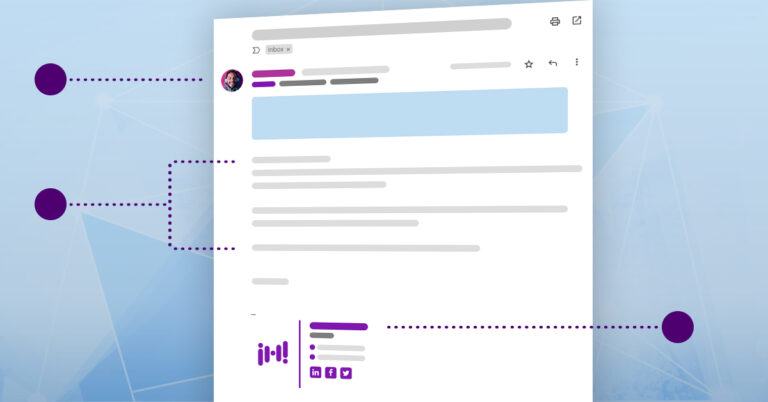Blog

Email nurture campaigns aren’t rocket science. If you’re staring at a blank Google doc, trying to figure out where to start your next campaign, just steal these. Really. They’re free.
But first, the basics. (If you don’t think you need the basics, treat the next few paragraphs like the personal essay before a recipe and just scroll on past.) Email nurturing is designed to help move your leads and prospects down your marketing funnel and get them closer to a sale.
It’s a basic idea, but that doesn’t mean it’s an easy one. Whether you’re stealing our nurtures or starting from scratch, please keep these two things in mind.
Rule One: It’s not about you.
From subject line to call-to-action, everything about your nurture emails needs to be dealing with the immediate benefit for the recipient. Maybe that’s learning something awesome from content, maybe you’re solving a pressing problem for them, there are a bunch of different options… but it shouldn’t just be an introduction to your company. Lead with the benefit, deliver on any promises you make, let them discover more about the company that just made their work better on their own time.
Rule Two: Measure everything— then act on it.
You should constantly be analyzing your email nurture camaigns, looking for the emails and offers that convert the best, and prioritizing content based on those results. Revisit your ongoing nurtures often, revising them based on the data. This also means that when a big batch of new prospects rolls in, it may make sense to engage with those leads on a staggered basis, to give you time to properly test and optimize the drip campaign.
Now that you’ve put your ego aside (at least a little) and got your analytics tool of choice all fired up for some actionable data, you’re ready to commit some Grand Theft Email.
Steal this nurture #1: The welcome nurture.

Welcome nurtures are often your first introduction to a prospect. They’ve filled out a form, now it’s your turn to follow up. Here are the three emails you need to include.
Email One: Here’s the thing you asked for!
The welcome nurture doesn’t exist in a vacuum. That lead came from somewhere! The first email they receive from you should directly apply to that. Include some details about your company and link to another resource related to the reason they gave you their email, but the star of this email should really be the link to the content they’ve asked for by filling out the form.
Email Two: The thing you didn’t know you needed.
Your next email should surface something that they didn’t know they need.
When someone becomes a lead, they fill out a form for a piece of content that sits in the middle of a specific Venn diagram. It’s 1.) A form of content that’s 2.) About a topic.

If you have another webinar (for example) about the same thing, that might be a great fit for this space, especially if it offers a different angle or a deeper dive on the same subject. If that’s your only webinar on that topic, following up with a white paper, podcast, or blog post along the same lines can be a great option.
This is also a stage where testing is critical. It may take a few revisions to figure out what piece of content performs best as a follow-up. The second email can be the difference between your company being a place your lead received one thing from and then sent straight to spam, or a brand that your lead starts to learn to trust.
Email Three: What else you got?
Email Three is a bit of an inflection point.
If the prospect has engaged with the second email in your nurture campaign, this is your chance to move them down your funnel. Sending middle-of-the-funnel content designed around the same topic gives you another opportunity to judge how primed your lead is for the sales team. If they engage again here, it might be time to pass them along.
In the cases where the second email didn’t connect, surface content from your other verticals here. Your initial piece of content is what caught your lead’s eye, but maybe they’re really a better fit for something else you offer. Use this email to get content from those verticals in front of them.
If you get to this stage and they haven’t engaged in a real way, here’s where they transition to your greater “check out our monthly newsletter!” workflow. They may not be ready to buy yet, but keeping them warm via your other marketing efforts is always wise. When they download another high value piece of content, you can move them back into this (or another) nurture and keep moving them further down your funnel.

What about sales emails? Here are 6 tips marketers should know to get them right. Read more
Steal this nurture #2: The reactivation nurture.
Things were going well with a lead… until they weren’t. The Reactivation Nurture email campaign gives you a shot at re-opening that relationship. These are the three types of emails you need to get those prospects moving down the sales funnel again.

Email One: The thirst trap.
You’re worried that your lead has forgotten about you. They aren’t opening your emails, they haven’t been to your website in a while, you had a dream that they found another provider. So, what now?
Go back to what worked the first time. This email should surface something pretty darn close to the thing that initially converted them. Ideally, it’s something that you’ve published recently, a piece of content that they would have missed after they ghosted you.
Offer something awesome, but don’t make it weird. If you can create some urgency with a limited-time offer or a discount, go for it. Just save the “Hey! We’ve missed you, u up?” messaging. It’s not a good look.
Email Two: A different angle.
Maybe you never knew your lead as well as you thought you did. Email Two in this nurture sequence is similar to Email One, just about a different thing. Yes, you still know what led them to become a lead in the first place, but if that’s not what they’re really looking for… what else do they want? If you’ve miscategorized the lead, what’s the other vertical they might fit in?
Send the best thing you’ve got that seems like it might be a fit. Again, keep it classy.
Email Three: Okay, get a little desperate.
What’s the scariest thing you’d do if you knew you could convert this lead?
How much of a discount would you offer? How far up your org chart would you let them book a meeting with?
This is the email where you offer them that thing. Put a time limit on the offer and mean it. Say it’s a one-time offer and mean it. This is your last second chance to save this lead before they walk out of your life forever.
But, like, play it cool.
If they don’t convert here, you can put them back in your “Here’s Our Newsletter” flow if you really want to, but it’s time to wash that lead right out of your hair. You’ve got other leads who will offer more of a return on your energy.
Steal this nurture #3: The abandoned cart.
Sometimes the fish takes a bite at your hook, steals the worm, and swims away without winding up in your boat. This nurture gives you another shot at that fish.
Email One: Whoops! You dropped this!
A literal abandoned cart nurture is a B2C mainstay. It’s used when a potential customer has literally put something in their figurative shopping cart— they were just a couple clicks away from turning into a paying customer.
For B2B companies, this is a little trickier. Here’s the reframe that makes an abandoned cart lead make sense: what’s the one action on your website that would go the farthest to turning a regular lead into a qualified lead?
We’ll use a “book an appointment” form as an example. Ideally, that has its own landing page. If your lead fills out that form, they’re ready to talk. No further action necessary.
But if they almost fill out that form? That’s your abandoned cart.
There are a handful of different ways you can set up the focus for this nurture. Ideally, it’s a combination of something like Hubspot and Hotjar.
What’s the email you send to someone who almost just moved themselves to the front of your sales queue?
An email that does the same thing.
In the few days after their abandoned cart, send an email that offers the same thing they almost signed up for. Don’t directly reference that you knew how close they were. Instead, your company just so happens to be doing a thing that weirdly resembles the offer your lead almost took you up on. Sweeten the pot, heighten the stakes, or lower the barrier a bit if there’s space to. A lead didn’t convert on scheduling a half-hour demo? Weird, anyway, here’s an email about scheduling a 15 minute demo before your experts are unavailable next week.
It’s a really simple idea.
Email Two: Juuuuuuust putting this out there.
Email two is the best performing email you’ve ever had. Okay, maybe we don’t know that yet, but you’re going to build it out of the best parts. Take the highest converting piece of content you have for the ICP or persona your cart abandoner fits in. Use the best performing subject line and email copy you’ve ever sent for that piece of copy.
But the link to that content doesn’t go to a paywall. It’s a landing page, just for this abandoned cart nurture. Downloading the content is easier than it’s ever been. And in the space where you’d normally put a paywall? Huh, weird, it’s the same offer they abandoned to start this whole thing. Who left that there?
Email Three: There is no Email Three.
Nope! If they don’t convert off these two little tricks, get ‘em back in their spot in the regular flow of things. Sometimes people just aren’t ready yet! We’ll get ‘em next time!
The Iron Horse insight.
Email nurture campaigns are a great tool for helping to move your leads along the buyer’s journey, and there’s a way to use a nurture for each step along the way.
But no one falls in love with a nurture, and they don’t make the decision to buy based on them. They’re an important part of a larger system, and writing the best nurture in the world won’t lead to the results you want if the other parts of your marketing efforts aren’t ready to do the heavy lifting.
Subscribe to our blog.
Get unstuck with the most interesting business ideas and our insights delivered to your inbox.